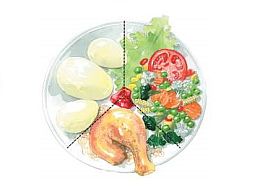Plan a Healthy Dinner with the Swedish Plate Model
A great tip to make you a healthy meal is to use the plate model. The plate model is often used in Europe and is a method for teaching meal planning. It is also used in the U.S. to illustrate the Dietary Guidelines for Americans, which is a publication given out by the USDA.
The Plate Model – A Visual Method

Swedish plate model
In this visual method, a plate serves as a pie chart showing proportions of the dinner plate covered by various food groups. The dinner plate can be divided in several sections. If we look at the Swedish plate model it is divided into three parts, whereas two of the parts are big sized and the third part is small sized. Here is how you dive the food groups:
Fill the two big sections with
- vegetables and root vegetables and
- carbohydrates such as pasta, rice, potatoes or bread.
Fill the smaller section with
- proteins such as fish, meat, eggs or legumes.
What to put on a healthy dinner plate
You can get a good and healthy meal if you put the following foods on your dinner plate:
Examples of vegetables (big section)
Preferably as much as three handfuls of vegetables per day and try to vary your vegetables. Choose something more than just tomato, cucumber and lettuce that contains mostly water. Try thicker vegetables such as broccoli, cauliflower, cabbage, peas, carrots and other root crops, that make you feel fuller and provide you with fiber, vitamin C and antioxidants. A tip to get enough vegetables on your plate is for example to mix the grated carrots in ground meat sauce and shredded cabbage in the wok.
Examples of Carbohydrates (big section)
Pasta, potatoes, rice and bulgur provide energy through carbohydrates. Choose fiber-rich carbohydrates. Bread is ideal for breakfast and snacks. Bread baked from whole wheat is rich in minerals. Sourdough breads are also good because the acid in bread lowers the GI (Glycemic Index).
Examples of Proteins (small section)
Meat, eggs or legumes (lentils, beans, chickpeas) are high in protein. Legumes are healthy and you can spice it with garlic, chili, coriander, cumin or herbs. Fish is also a good source of protein, which contains the beneficial omega-3 fat. Try to eat fish often, preferably 2-3 times a week. Fat and lean fish, such as salmon and herring are great choices.
Adjusting the plate model
If you are overweight you can let the vegetable section be even greater. Let the vegetable section cover half the plate instead. On the other hand, if you weigh too little, increase the amount of carbohydrates and proteins.
-
Advertisement

 Facebook
Facebook  Twitter
Twitter  RSS
RSS







